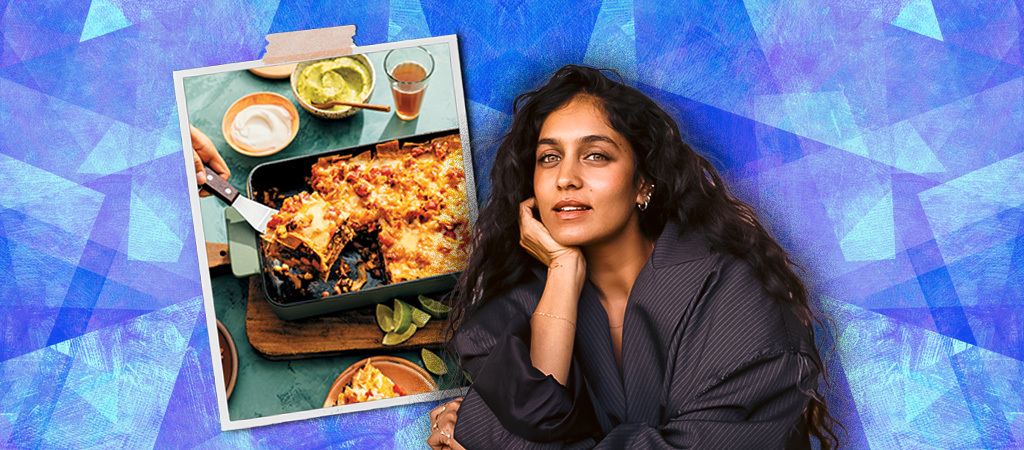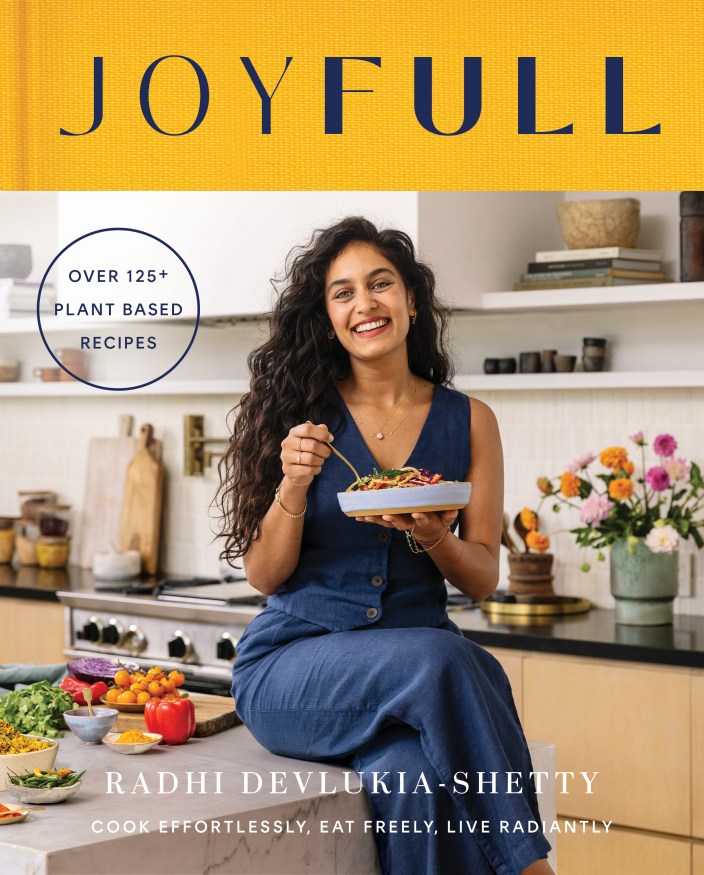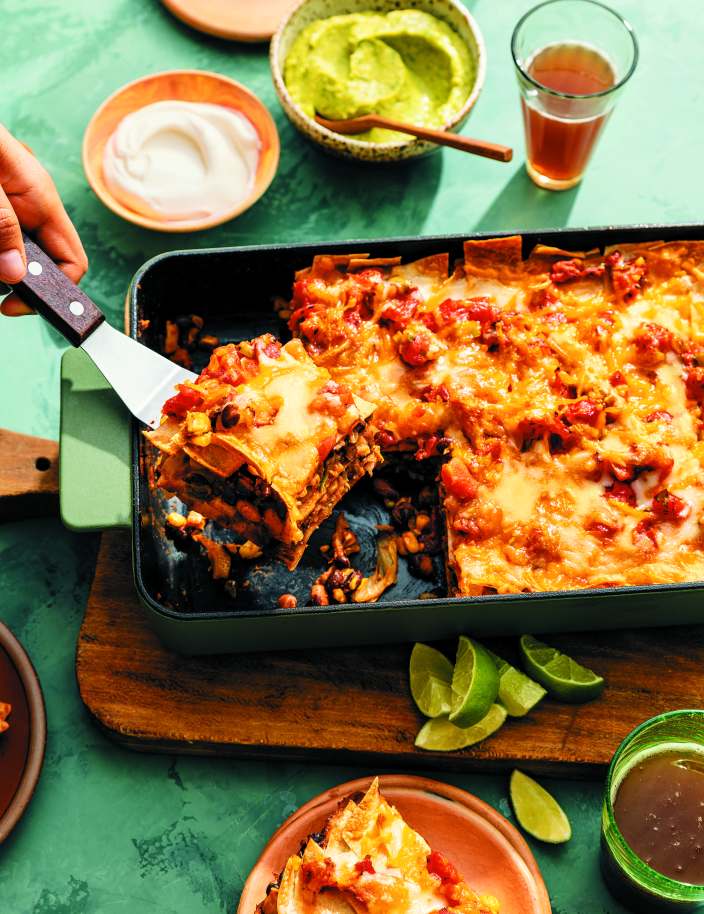
Radhi Devlukia’s Joyfull cookbook is a crash course in finding your inner veggie-forward eater and the joy that accompanies the light-footed feeling of healthy plant-based consumption. GMOs be exiled, corn syrup be gone, leave the animals in the pastures — not in Radhi’s pantry!
A well-educated nutritionist and dietician who spent most of her life in the UK learning to cook under the tutelage of an Indian mother and Grandmother, Devlukia has jumped the Atlantic to live in the United States and we’re all better for it. Her veggie-based dishes are a blend of the one pot cooking common in most culture’s comfort foods, dynamic spices found in Indian households and in many instances the efficient composition and cooking techniques of the never-having-time-to-relax US lifestyle.
We took time from Radhi’s packed promo schedule to learn about the Indian nutritional concept of Ayurveda, the optimal ways to harness the natural flavors of veggies, and the secrets behind how her Mexican Lasagna is animal protein-free but boasts enough dynamic flavor to satiate your hangriest carnivore friends and family.

Can you tell us a bit about your background and your history with cooking?
I grew up in an Indian family where food, like many cultures, was basically the center of pretty much everything. My Mom had a full-time job, but she would create fresh breakfasts, lunches and dinners for us every single day. I think that was a big part of it – she fueled my love for food. I saw how much love she poured into the food. I saw how excited she was creating it and experimenting in the kitchen and it really did leave such a deep impression on me.
I was thinking about what I wanted to do when I was going to university. At first I thought I wanted to be a doctor, like a lot of Indian people do, but I didn’t get the grades for that so I couldn’t do it. My Mom recommended I go into nutrition, at the time, I hadn’t really thought about that as a path or something I could have a job in. I kind of went into nutrition accidentally because I didn’t really know what else to do. It started just igniting my love for understanding the body and how food affects our bodies.
I ended up doing a second degree to be a clinical dietician. So I did my nutrition degree and I was like, this is amazing but I really want to work in a clinical setting because that has always been my dream. Then, I did a full other degree to become a dietician, so I am a nutritionist and a dietician.
I absolutely loved being able to help people through food. I would do everything from pediatric clinics for fussy eaters to diabetes clinics to FODMAP (fermentable oligosaccharides, disaccharides, monosaccharides and polyols) to helping people with IBS and gut issues. At the same time helping people who’ve been in surgery and have to be on drip feeds. I was doing such a variety of helping people get nutrition but in so many different ways.
I still felt like there was something missing because as much as I appreciated what I was doing, there was a disconnect; telling people what to do and helping people tune into their body to understand what they need versus me just regurgitating information. I had to leave the UK to go to New York for my husband’s work. When I got there, I couldn’t use any of my skills or my degrees since I didn’t have a work permit, so I ended up going back into study and came across Ayurveda. Even though I’d grown up with it because it’s part of my culture, it wasn’t something that I thought of as a practice.
“Ayur” means life and “Veda” means knowledge, it’s basically the most beautiful holistic health science to exist. It’s all about how nature can heal your body, but even more than that, how you can tune into your body to understand what it really needs.
When I learned about Ayurveda, it felt like home for health for me. Learning about it and doing the practices – I felt like I found a way to optimize my own health and I really wanted to share that with everyone. I took all of that and pulled it into a book where I share everything that I’ve learned throughout the years, plus all of the practices and rituals that have enriched my own life are weaved through the recipes that I’ve created.
You mentioned your family and your roots, how would you say that those elements of your upbringing influenced your cooking style?
My heritage is in every single part of this book. I was so happy I got to have my Mom and my Grandma be a part of the pictures because it would not have felt complete without people being able to see them. Everything from the spices I use, to the techniques that I use in cooking, it’s been through watching them cook.
Spices are my favorite thing to talk about and my favorite thing to use in the kitchen. I can’t imagine a dish without spice. I’ve gotten that from my Indian heritage because every single Indian person has a spice box. In English it translates to a seven compartment spice box and you have your essential spices in there, you do not cook without it, it’s the first thing that’s taken out when you start cooking. My Grandma has one, I have one, my Mom has one and my Sister has one. That’s where so much of the flavor in my food comes from, it’s a combination of my heritage but also where I’ve lived.
I was born and raised in the UK, so there’s so much influence from the UK. I’ve been in the US for about seven years now and I’ve spent so much time in India and other countries, the cuisines in this book are a mixture of all of that. Growing up we practiced specific things with food, my Mom would always pray before we ate, it was a part of my culture. I grew into appreciating it as I got older, at first I was like, “Can I just eat? I don’t want to wait to pray, I just want to eat” but I’ve learned how much it changes your perspective of the food you are eating by just having a moment of gratitude for it.
The way that you interact with the food that you are eating and consciously preparing so that it nourishes the people you are feeding. It’s not just throwing everything around and eating a burrito while you are working, it’s like, wow, this food has the ability to fully nourish my body, my heart and so much more than that. I think that it all comes from where I’m from, that’s what I’ve grown up with and I only realized it later on in life.
You mentioned spices and how that brings together a big part of the foundation of your cooking. What are some of your typical pantry staples?
Well, to start off with, I have three big drawers of spices in my house they’re all there. They are my favorite favorite drawers because they’re the most organized part of my kitchen. They are all in alphabetical order and I have so many. I find when people are starting off fresh with spices to really appreciate spice blends.
Instead of getting all these spices, you have no idea what to do with, what’s amazing is you go and buy a taco seasoning or a garam masala. Garam masala is one of my favorite go-tos. If I’m making a lentil dish or a vegetable dish, if I want to add a bit of flavor, I always lean towards the Indian flavors, just because there’s so much vibrance in it. I’ll just throw in a tablespoon of garam masala and it will elevate the dish so much.
I say, get yourself good spice mixes. There’s Chinese five spice, it’s incredible and I put that into some of my noodle dishes. You can also get one spice blend from each cuisine and then experiment. Some of my favorites at the moment are coriander, cumin, and fennel. One because I love the flavor, but also because in Ayurveda it teaches us how these three spices when mixed together are an incredible digestive blend. Adding in spices doesn’t just elevate the food, I mean the flavor of it, It completely changes the way your body digests it.
Spices are medicine. The way that spices are, they’re potent, they have so much nutritional benefit in them. They actually help break down and digest food.
I want to talk about your veggie forward cooking. Do you have any tips for picking out the best produce at the market?
If you are in a place where you have farmer’s markets or little farms that you can get things from you can really taste the difference. Think about the freshest ingredients, when you pick an apple from a tree, when you pick a tomato, when you pick herbs that have just come out, everything is at its peak flavor the second that it’s picked.
The easiest way to think about this is, how long has it been since this has been picked? The longer it’s been, the less flavor that it’s going to have, and the less nutritional benefit. I love to think of my food in that way.
The fact is organic fruit and vegetables are always going to be better. By the time apples have gotten to me, I know they have probably been around for over a month, sometimes two months, sometimes three months. A coating is put on them to stop them from going bad on the inside, and you have no clue about it. So the best thing is to try and go to little farms and farmer’s markets.
If you don’t have farmer’s markets, pick organic produce when you go to the grocery store. Pick things that are in season because it’s more likely that you’ll find better organic produce that is in season rather than not.
One of the tips that I love is when you’re trying to figure out whether an avocado is ripe. You can take off the little top nip – there’s a little round bit at the top of your avocado – when you take it off, if it’s got a green color, it’s not ripe, if it’s yellow, it’s perfectly ripe.
Do you find cooking and getting big flavors out of vegetables to be a challenge?
Yeah, I would say it is difficult. Since I came to the US, I noticed such a difference between UK produce and US produce. It’s so interesting because when you go to Italy, for example, when you taste tomatoes that are from there, the flavor difference is incredible. It’s incredible to see and it’s all dependent on the soil that it’s grown in, the climate that it’s in, all of that impacts it. Also, how much sun the fruit or vegetable is getting really penetrates the flavor.
Don’t overload a vegetable with flavor. Vegetables already have a flavor, and so using lighter seasonings and sauteing vegetables can bring out the flavor.
It’s the same with spices by the way. You may smell a spice and it smells great as it is, but then as soon as you saute it in a fat, it releases all the aroma and activates the health benefits too. Whether it’s veggies or spices, I really recommend activating them in some sort of fat. Also, they’re easier to digest when you end up cooking them or at least lightly cooking them. Raw vegetables can be quite difficult to digest, so I recommend lightly cooking veggies to get the benefit from them.

Is there a vegetarian dish that you find particularly savory and satisfying? For example, we came across your Mexican lasagna, would that fall into that category?
Yeah, definitely. I always like a good balance of things. In the Mexican lasagna, there’s veggies, beans and layers of the tortilla wraps, which are your carbs. There’s a dairy aspect of vegan dairy, of the cheese. There are different textures.
I just think that it’s always nice balancing out the macros – making sure you’ve got a balance of all different types of ingredients that are providing different things for you. With one pot recipes you can throw whatever you want into them, right? When I make this Mexican lasagna, I’ve got a few veggies in there, I’ve got cabbage and I’ve got peppers, but sometimes I’ll look in my fridge and if I’ve got some zucchini lying around or some celery, I’ll chop up as many veggies as I can into every dish.
I think vegetables are actually really easy to make. When you’re blending it, you can add more veggies like in a sauce. You think it’s just tomato sauce, but you can add some celery into that. I’ve also added zucchini and spinach into things and no one’s even known.
I made zucchini brownies the other day and no one had a clue that there was zucchini in there. I think there are really beautiful easy ways to sneak in veggies. I recommend to people that if you see a dish and you’re going to make it and it doesn’t have vegetables in it, find a way to incorporate some. Chop them up really small or have some as a side dish.
I personally feel no meal is complete without having a vegetable in it.
What would you say are some of the elements that people love about your Mexican lasagna? Is it something that you would recommend to somebody that’s a novice cook or just getting into veggie forward cooking?
Yes, it’s super easy because you’re literally just layering. It’s a one kind of dish thing. You have to just put it into the oven. You’re making a filling, layering up the tortilla wraps, filling tortilla wraps, adding cheese and putting it into the oven. I’d say it’s a really good, easy dish.
People love the Mexican lasagna because it just feels hearty, it’s a solid comforting meal. You get all the bits that you want from it, and it tastes a bit cheeky, but it is not deep-fried. It hasn’t got any nasty things in it and still feels very comforting. For someone who’s looking for a filling meal, you’re getting some good nutritional benefit from it, from the beans and the veggies. It’s a good balance of both.
Do you think that people that are used to eating animal proteins will miss the meat, or is it something that’s pretty satisfying for anybody?
I think it’s pretty satisfying for anybody. That’s because a lot of people think when you eat vegan food or plant-based food, it’s going to lack flavor, that’s why I think I love spices. They are the secret to eating plant-based meals and being excited by them. I’ve had so many people eat at my house, and I only cook plant-based food.
Most of the people that come are used to eating meat and I’m sure they’re not going to tell me that they don’t like it, but from my experience, people say that they feel so satisfied by the meal because there are so many different textures and flavors. Your senses get excited by that and that’s what you really want from a meal. Even if something feels unfamiliar, if it’s exciting for your senses, you’re going to end up loving it anyway, even if it’s not a texture or a component of a meal you’re used to.
Do you think it’s possible to convert a carnivore?
I never really think of it as converting people. I feel like as people get introduced to plant-based food, let’s say somebody decides that they want to have a day, one day out of the seven days that they’re going to decide to have a plant-based meal. I think it’s more when you see the benefits of something and you feel the benefits of it. You naturally start going towards the thing that makes you feel good.
I totally value and get why some people find it really difficult to swap over or make those swaps, but always my response is to try it, see how you feel. If it doesn’t work for you, don’t do it but more often than not, people are like, “Wow. On that day, I actually felt so much lighter. I felt like I had more energy”. They start saying, “My skin looks so much better when I gave up dairy.”
There’s so many benefits to becoming plant-based that I think once you end up feeling it or seeing it, that’s usually how we end up changing, right? We either feel the benefit or we see something that’s beneficial. “Oh my gosh, my pain from my arthritis has gone down so much, my inflammation has gone down.” You end up changing based on what you see, what you hear and what you experience. As soon as people get that, I think it’s an easy win.
How To Make Mexican Lasagna

Ingredients:
Filling:
• 1 tablespoon sunflower or avocado oil
• 1 cup finely chopped or shredded cabbage
(about 1/2 small head)
• 1 1/2 cups cooked black beans or 1 15-ounce can,
rinsed and drained
• 1 1/2 cups cooked pinto beans or 1 15-ounce can,
rinsed and drained
• 1 cup fresh sweet corn kernels (about 2 ears) or
thawed frozen
• 3 tablespoons finely chopped pickled or fresh
jalapeño (about 1 large pepper)
• 2 1/2 teaspoons taco seasoning (or 1 teaspoon
each ground cumin, paprika, and dried
oregano)
• 1 teaspoon sea salt
LASAGNA:
• Olive oil cooking spray, sunflower oil, or avocado
oil
• 4 of your favorite 8- or 10-inch tortillas, cut into
• 1-inch-wide strips
• 1 cup of your favorite salsa or canned crushed
tomatoes
• 1 cup shredded vegan cheddar cheese or a blend
of cheddar and mozzarella
FOR SERVING
• Guacamole
• Vegan sour cream
• Tortilla chips (optional)
Method
Preheat the oven to 425ºF.
1. MAKE THE FILLING:
In a large skillet, heat the oil over medium heat. Add the cabbage and cook, stirring, until softened, about 5 minutes. Add the black beans, pinto beans, corn, jalapeños, taco seasoning, and salt and cook, stirring occasionally, until the flavors have come together and the seasonings are aromatic, about 5 minutes.
Remove the pan from the heat and set the filling aside.
2. ASSEMBLE THE LASAGNA:
Lightly coat an 8-inch square baking dish with cooking spray. Spread about one-third of the tortilla strips in an even layer across the bottom, trying to avoid any gaps. Add half of the bean mixture in another even layer, followed by another one-third of the tortilla strips. Layer with the remaining bean mixture and top with the remaining tortilla strips.
Finish with the salsa and cheese. Bake until hot and bubbling, about 20 minutes.
3. TO SERVE:
Cut the lasagna into squares and serve with the guacamole and sour cream, plus chips, if you like.
Store leftovers in a sealed container in the refrigerator for up to 3 days.
